Ming's Ivory Jewelry, founded in the early 20th century, merges ancient traditions with meticulous craftsmanship. You'll find pieces inspired by Chinese mythology and folklore, making each item a symbol of cultural heritage. Artisans use traditional tools and techniques to hand-carve and polish fine ivory, revealing its natural beauty. Iconic items like dragon pendants or phoenix earrings carry deep symbolic meanings. Though ethical considerations and regulations now impact ivory use, proper care and storage can preserve these timeless pieces. As you discover more, you'll gain deeper insight into the history, artistry, and market trends surrounding Ming's ivory jewelry.
Key Takeaways
- Ming's Ivory Jewelry is renowned for its meticulous craftsmanship and historical significance.
- Iconic pieces like the Dragon Pendant and Phoenix Earrings symbolize cultural myths and values.
- The jewelry combines traditional carving techniques with modern designs for unique aesthetics.
- Legal restrictions and ethical considerations impact the trade and production of ivory jewelry.
- Proper care includes storing in a cool, dry place and avoiding harsh chemicals.
History of Ming's Ivory
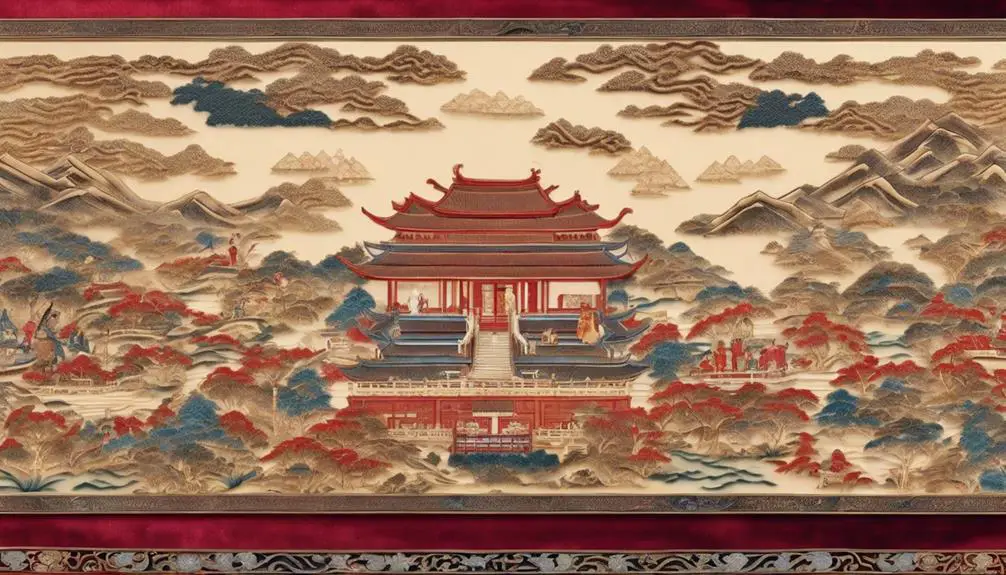
In the early 20th century, Ming's Ivory began crafting exquisite jewelry that quickly gained international acclaim. You'd be fascinated to learn about its historical origins, deeply rooted in ancient traditions. Ming's Ivory didn't just appear overnight; it has a rich backstory that intertwines with the cultural significance of ivory in various societies.
Imagine yourself in a bustling Chinese marketplace, where ivory was once a highly prized material. For centuries, ivory had symbolized wealth and power, often used in religious artifacts and royal regalia. Ming's Ivory tapped into this cultural heritage, transforming it into beautiful, wearable art. The founders understood that they weren't just making jewelry; they were preserving a piece of history.
Over time, Ming's Ivory became more than just a brand; it became a cultural icon. The intricate designs often incorporated motifs from Chinese mythology and folklore, making each piece not only a fashion statement but a storytelling medium.
You'll find that the jewelry from Ming's Ivory carries layers of meaning and tradition, connecting you to a bygone era while allowing you to appreciate the artistry and cultural depth of its historical origins.
Craftsmanship Techniques
You'll marvel at the meticulous techniques Ming's Ivory artisans use to create their stunning jewelry pieces. Each item begins with the careful sourcing of materials, ensuring only the finest ivory is selected. The process starts with a deep respect for nature, as artisans choose pieces that are both ethically and aesthetically suitable.
Once the ivory is sourced, traditional tools come into play. These tools, passed down through generations, are essential for preserving the authenticity and quality of the craftsmanship. Using chisels, files, and carving knives, artisans intricately shape each piece, paying close attention to every detail. You'll notice that no modern machinery can replicate the precision and artistry achieved by these traditional methods.
The next stage involves polishing and finishing. This isn't just about making the ivory shine; it's about highlighting the inherent beauty of the material. Artisans use natural polishing stones and fine sandpaper to bring out a lustrous finish, ensuring each piece stands out.
As you explore Ming's Ivory jewelry, you'll appreciate the dedication and skill that go into every creation. The combination of carefully sourced materials and traditional tools results in jewelry that's not just beautiful but a tribute to timeless craftsmanship.
Iconic Jewelry Pieces
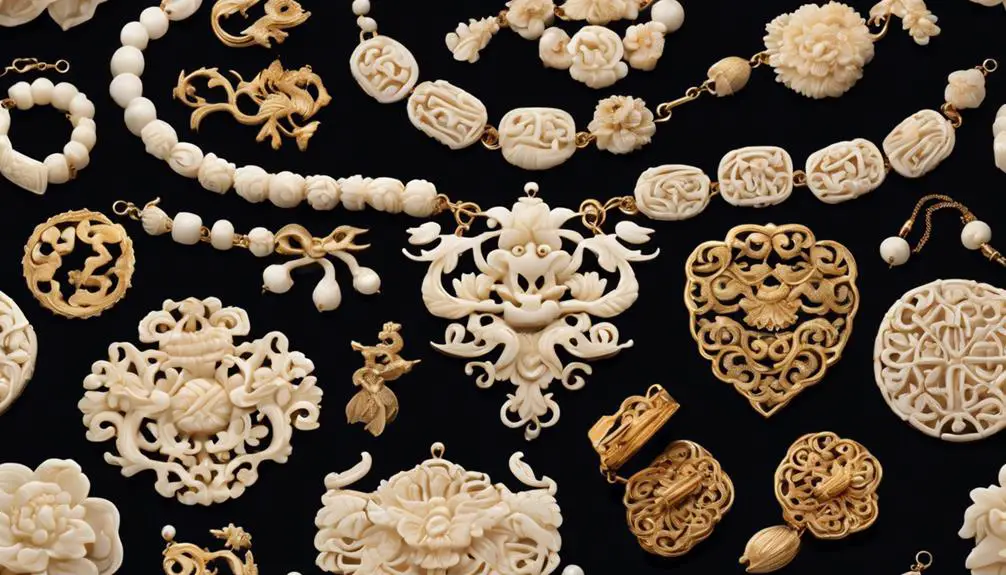
Ming's Ivory artisans transform their expertly crafted materials into iconic jewelry pieces that captivate and inspire. Each piece holds deep cultural significance, reflecting the rich heritage and artistry of the region. You'll find that these jewelry items aren't just beautiful; they're also meaningful symbols that resonate across generations.
To give you a clearer picture, here's a quick look at some of the most popular pieces and their unique characteristics:
| Jewelry Piece | Description |
|---|---|
| Dragon Pendant | Symbolizes power and prosperity, extremely popular in Asia |
| Phoenix Earrings | Represents rebirth and immortality, cherished in many regions |
| Lotus Bracelet | Signifies purity and enlightenment, widely admired globally |
These pieces aren't just about aesthetics; they're imbued with stories and traditions. The Dragon Pendant, for example, is a symbol of power and prosperity, making it a staple in Asian cultures. The Phoenix Earrings, loved for their symbolism of rebirth and immortality, enjoy regional popularity across different continents. Meanwhile, the Lotus Bracelet is admired worldwide for its association with purity and enlightenment.
When you wear a piece from Ming's Ivory, you're not just donning a piece of jewelry; you're embracing a piece of cultural heritage that transcends time and borders.
The Art of Carving
At the heart of every exquisite piece lies the art of carving, where skilled artisans bring ivory to life with meticulous detail and precision. You can almost feel the passion and dedication they infuse into each piece, turning raw ivory into breathtaking jewelry. These craftsmen draw from a rich array of inspirational sources, including nature, mythology, and historical events, to create designs that captivate the eye and stir the soul.
Cultural influences play a significant role in shaping the final product. For instance, Asian motifs often feature intricate dragon and phoenix designs, symbolizing power and rebirth. Similarly, African artisans might incorporate tribal patterns that tell stories of their ancestors. These cultural nuances not only add depth to each piece but also make them unique and meaningful.
When you look at a finished piece, you're not just seeing ivory shaped into a form; you're witnessing a blend of history, culture, and artistry. Each curve, line, and intricate pattern is a reflection of the artisan's skill and the rich tapestry of inspirational sources. This marriage of craftsmanship and cultural influences ensures that every piece of Ming's ivory jewelry is a true work of art.
Ethical Considerations
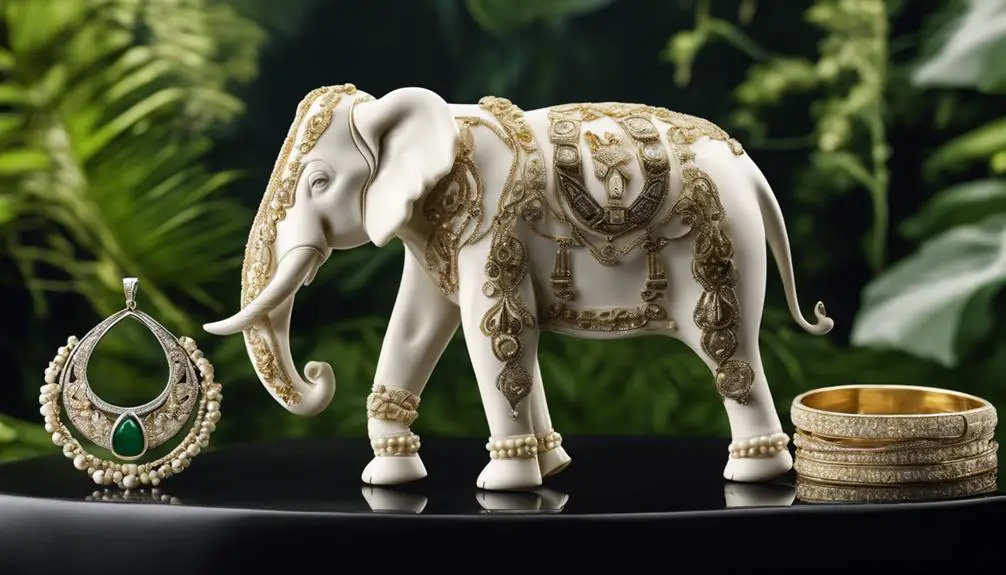
Understanding the ethical considerations surrounding ivory jewelry demands a thoughtful and informed approach. When you think about ivory, you must consider the impact on wildlife conservation. Elephants, often hunted for their tusks, face severe threats due to poaching. By choosing ivory jewelry, you may inadvertently support activities that harm these majestic creatures and disrupt ecosystems.
Legal regulations also play a vital role. Many countries have strict laws banning the trade of ivory to protect endangered species. Before buying or selling ivory jewelry, check the legal framework in your region. Violating these regulations can result in severe penalties, including fines and imprisonment. Additionally, understanding these laws helps you make ethical choices that align with global conservation efforts.
It's important to question the origins of any ivory jewelry you encounter. Ethically sourced ivory, such as antique pieces, may be legal but still raises questions about the broader implications for wildlife conservation. By being informed and cautious, you can contribute to the preservation of endangered species and uphold legal standards.
Collectors' Insights
Many collectors of ivory jewelry value its historical significance and intricate craftsmanship. You're likely drawn to these pieces because they tell a story of cultural heritage and artisanal skill. Each item isn't just jewelry; it's a piece of history that has been meticulously carved and preserved over time.
Collector motivations often include a desire to own something unique and irreplaceable. Ivory items, especially those from the Ming Dynasty, are rare and offer an unmatched charm. The rarity factors play a huge role in their appeal. With strict regulations and ethical concerns limiting the availability of new ivory, existing pieces become even more precious. You're not just acquiring jewelry; you're investing in a relic that's part of a dwindling supply.
Additionally, the intricate designs and craftsmanship found in Ming's ivory jewelry are unparalleled. You appreciate the detailed work, knowing that each piece required immense skill and patience. Owning such items allows you to connect with a bygone era and its artistic expressions. For you, it's not just about possession but also about preserving and celebrating a rich cultural legacy.
In essence, your passion for ivory jewelry is fueled by its historical depth, rarity, and exquisite craftsmanship.
Caring for Ivory Jewelry
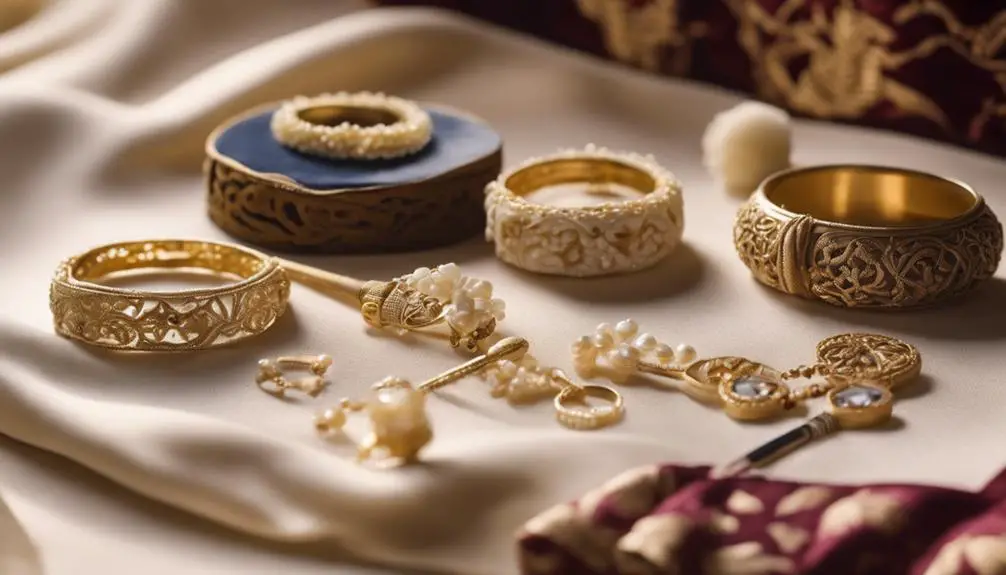
Preserving the intricate beauty and historical significance of your Ming ivory jewelry requires careful attention. First, understand that proper storage is essential. Store your ivory pieces in a cool, dry place away from direct sunlight. Excessive heat and moisture can cause cracking or discoloration. Use a soft cloth or a padded jewelry box for additional protection.
When it comes to cleaning methods, always handle your ivory jewelry with clean, dry hands. Avoid using harsh chemicals or abrasive materials, as these can damage the delicate surface. Instead, gently wipe the jewelry with a soft, damp cloth.
For deeper cleaning, you can use a mild soap solution, but make sure to rinse thoroughly and dry completely with a soft cloth.
Modern Interpretations
In today's fashion world, Ming's ivory jewelry has been reimagined with contemporary designs that blend traditional craftsmanship with modern aesthetics. These pieces are no longer just relics of the past but are transformed into cutting-edge accessories that complement today's fashion trends.
You'll find that the intricate, hand-carved details of Ming's jewelry are now paired with sleek, minimalist settings. This fusion creates a striking balance that appeals to both lovers of classic elegance and enthusiasts of modern style.
Innovative applications of technology have also played a significant role in this transformation. For instance, 3D printing techniques allow for more precise and complex designs that were previously unimaginable. This means you can now enjoy unique, custom pieces that showcase both the artisan's skill and the versatility of ivory as a material.
Additionally, designers are experimenting with combining ivory with other materials like gold, silver, and even recycled metals to create hybrid pieces that are both sustainable and stunning.
Market Trends
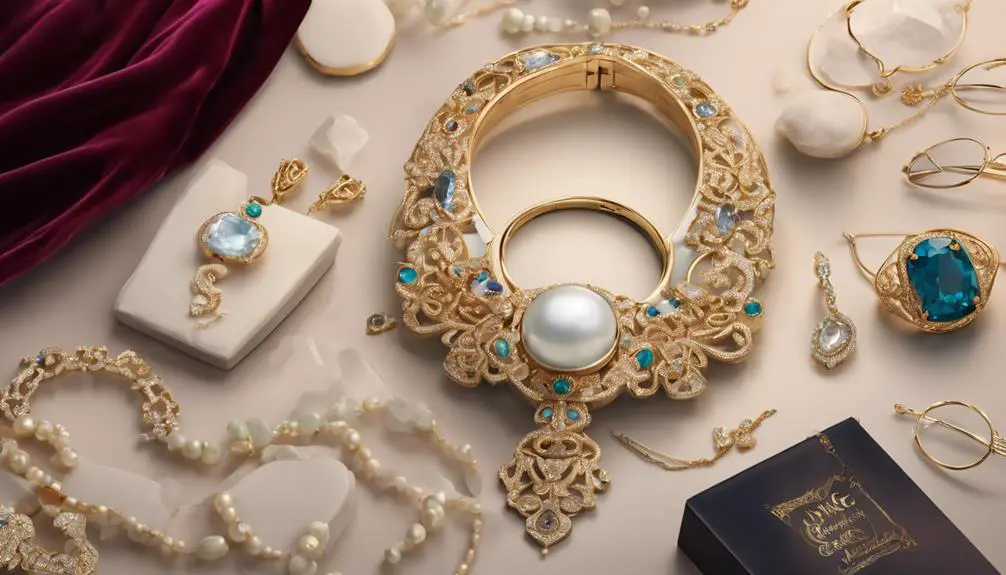
The demand for Ming's ivory jewelry has surged as collectors and fashion enthusiasts alike seek out these timeless pieces. This surge is driven by a global demand for unique, high-quality jewelry that stands out in a crowd.
When you're looking at the market, you'll notice that the appeal of Ming's pieces isn't confined to one region; they're sought after worldwide, from New York to Tokyo.
With this increased interest, you'll see pricing fluctuations becoming a common theme. Prices can vary greatly based on factors such as the age, rarity, and condition of each piece. One week, a particular piece might sell for a modest sum, while the next week, a bidding war could drive the price sky-high. It's essential for you to keep an eye on these trends if you're considering buying or selling.
Understanding the global demand and pricing fluctuations can give you an edge. Whether you're a collector or an investor, staying informed about market dynamics helps you make savvy decisions.
You'll find that timing your purchases and sales according to these trends can maximize your investment and appreciation for Ming's exquisite ivory jewelry.
Conclusion
You've explored the rich history and craftsmanship of Ming's ivory jewelry. You've learned about iconic pieces and the intricate art of carving.
Ethical considerations remind you of modern responsibilities, while collectors' insights and care tips help you appreciate these treasures.
Modern interpretations and market trends show that Ming's legacy continues to evolve.
Embrace this knowledge as you navigate the fascinating world of Ming's ivory jewelry, always mindful of its cultural and ethical context.